Looking At The Box
Art (What’s supposed to be in the boxes.)
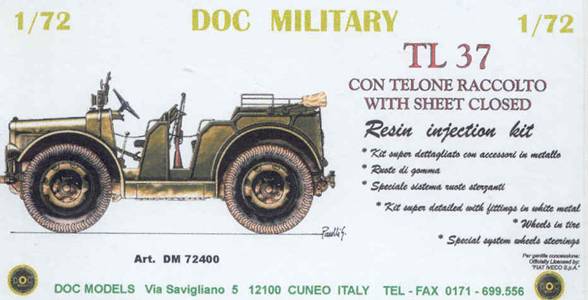
DOC’s version of this small artillery
and towing tractor comes packaged in several compartmentalized plastic
bags in a light cardboard box. I think this kit was released in the
late 1990’s. The box art shows a profile of the towing tractor
in gray-green camouflage color, and with the canvas cover stowed,
or as DOC states it: “with sheet closed”. The vehicle
was made for off-road use, hence the large tires and 4x4 (4-wheel)
drive. We can make out the spotlights on the windshield sides, gear
shift on the floor, steering wheel, and a rifle rack behind the front
seats. On the rear deck is a small frame, or cage, for holding gear
on the deck, this frame is not included in either the DOC or the ACE
model. At the lower rear is the towing pintle.
My reference states the payload was 800 kg and this vehicle also came
with a truck body: the AS37. I have read that the vehicle served in
all Italian campaigns and was used by the Germans and the Allied forces
when captured. My guess is that we can model the TL 37 towing weapons
up to 75 mm field guns and 105 mm howitzers, and single axle fuel
and ammunition trailers.
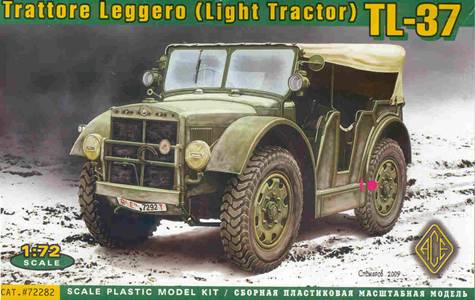
Here we have the wonderful box art for ACE’s version of the
Italian TL-37 in 1/72 scale (I love ACE’s box art) released
in 2010. On the nose under the radiator grill, is a simple license
plate for the Italian Army. The vehicle has an olive or gray-green
color; gray-green which is typical color for Italian military vehicles
in Europe (Russia, Italy, the Balkans, etc.). An African theatre vehicle
would be a desert tan color. Like in the DOC box art, the canvas cover
is a light tan color. The seat cushions appear to be brown leather.
The canvas tarp is deployed, opened up, which makes sense for a vehicle
set in a winter scene. However the opened canvas cover is not included
in the ACE kit. The two headlights also have canvas covers to restrict
the light beam in combat areas. The good-luck horseshoe on the radiator
grill is not included in the model.
Looking At The Parts
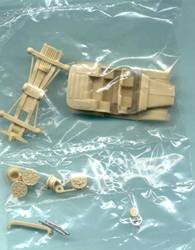
DOC’s kit consists of 10 light amber cast resin parts, 11 cast
metal parts, a clear plastic sheet for the windshield, and five soft
rubber tires, in three clear plastic bags. At top right we see the
one-piece tractor body which is very well cast with few imperfections.
Because it is cast in one piece, there is no recessed foot area for
the driver’s feet and gas & break pedals; something that
can be visible and annoying if you build it with the canvas stowed
away. I don’t see much interior detail. A good thing to the
truck body being cast as one piece is that we will not have to deal
with fitting body parts together and filling seams.
At upper left is the frame and rudimentary axles with little ball
mounts for the wheels. The ball feature fits into holes in the wheel
rims which make it easy to have the front wheels turned left or right.
In the center are the five wheel rims for the separate soft rubber
tires.
I initially did not believe this tractor had all-wheel steering like with the Italian OM 32
light truck but Ilian Filipov from Bulgaria sent me some photos correcting me that the vehicle did
indeed have all-wheel steering.
Lower right is the cast metal steering
wheel; too thick and crude for a good display model. I don’t
see an exhaust muffler or pipe, something we’ll have to scratchbuild.
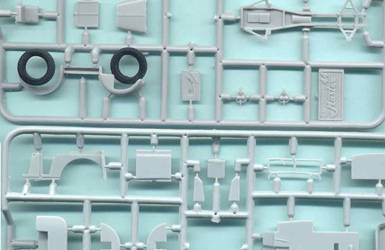
Here are parts of two different, representative sprues from ACE’s
TL 37 model kit. For a full view of ACE’s kit sprues, please
see their website.
The ACE TL 37 has 45 light gray, injection molded parts, and five
soft rubber tires,
While most small scale truck kit makers make their tires also out
of injection molded styrene like the rest of the kit. ACE in this
case uses black soft rubber for their tires which are decently molded
with little flash. The tire tread is very well done. At lower left
is a section of the tractor body showing little interior detail, just
as with the DOC kit. Upper right is the vehicle frame which appears
more in-scale and accurate than the DOC kit. Overall molding is good
but there are some flash and sink holes, which are common features
of many short-run models.
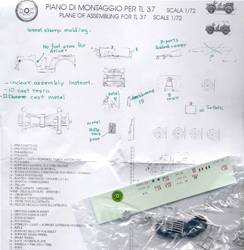
This is all that DOC gives us for assembly instructions; on it I’ve
taken notes with a green pen. The drawings are faint in areas, probably
due to photocopying the instructions too often. At lower left is a
list of the kit parts in both Italian and in English. It is odd that
I do not see a towing pintle included. Though the list is numbered,
the actual kit parts are not numbered. With these instructions we
are going to have to study the parts very well and need good photo
references and to build the DOC kit.
Lower right is a plastic bag holding the kit decal markings, rubber
tires, and many of the cast metal kit parts. The metal parts are fairly
crude and thick. The water-slide decal markings look good and there
are markings for four or five Italian vehicles and one German; unfortunately
there is no guide as to decal placement or unit identification.
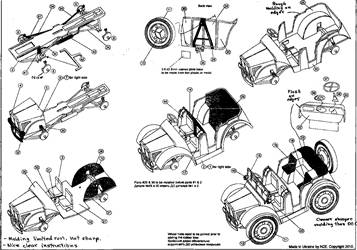
Here is one section of ACE’s kit instructions
which are the common exploded-view instructions in seven parts. On
ACE’s first page is a parts diagram showing the part locations
and numbers. It looks like there is no rifle rack for the back seat
in this kit. In the first diagram we see the exhaust muffler and pipe.
Despite the box art showing the canvas cover open we see here that
the kit depicts it folded up. Here is a good point to notice that
the Italian military vehicles had the driver on the vehicle’s
right side, like with UK vehicles.
For both the DOC and ACE kit, the rear middle seat cushions are missing
but we can replicate them with some thick plastic card.
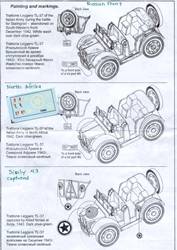
The last page of ACE’s instructions shows the placement of the
markings for three TL 37s. At center left are ACE’s water slide
decals for this model kit, good for several Italian vehicles and an
Allied captured version.
Both kits have their good points and weaknesses
and both will build into a decent TL-37 tractor. Not having fully
built either of them yet, the ACE injection-molded plastic kit appears
to build into a better display model DOC’s major weaknesses
are the cast metal parts and the so-called assembly instructions.
With DOC’s sparse interior, I recommend you buy the version
with the canvas cover up.
References
[1] The Observer’s Fighting Vehicle Directory of WW2, by Bart H.
Vanderveen, (1969).
[2] www.acemodel.com.ua
[3] www.docmodels.com
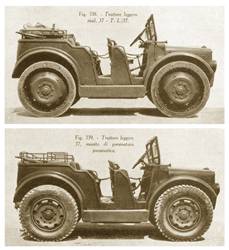
Here’s a good right side view of two TL 37 tractors I’ve
found at several websites. The lower vehicle is the version DOC and
ACE offers, with pneumatic tires, while the upper photo has solid
rubber tires. Ropes go across the doors to keep the crew from falling
out, On the side of the windshield, the spotlights are not present
but there is what looks to be a long horn, the kind with the rubber
bulb like I had on my first bicycle. On the rear deck is the railing
for equipment storage.
Not visible here are doors on the rear which I presume are for ammunition
and gear storage.
Editor's note: for a preview of the DOC AS37,
click here. |